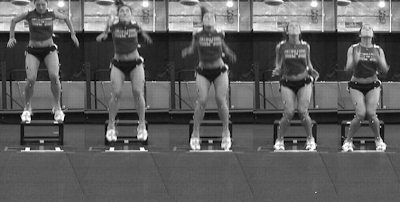
Despite some great efforts by sports scientists and coaches, knee injuries like ACL tears are NOT decreasing! In fact, 2011 research conducted by orthopedic surgeons from The Children’s Hospital of Philadelphia shows that anterior cruciate ligament (ACL) and meniscus tears among adolescent athletes have increased dramatically over the past 12 years. One of the trends that have progressed with this increase in incidence is the greater frequency of playing sport, longer practices, more showcases, and larger tournaments. The level of competition is so high that athletes now just play one sport 11-12 months a year, exposing athletes to a greater number of non-contact landings in the same setting repeatedly. This higher frequency of exposure, despite an athlete and coaches best effort, makes knee injuries more likely because the biggest cause is landing incorrectly.
Bad landing mechanics will negate any previous strength training through 2 primary avenues; increasing the load on the knee joint and changing the position of the knee joint upon this landing.
The first cause, increasing the load on the knee, is most often due to improper tracking, where the foot and knee are not aligned in the same direction. Most frequently this misalignment is from a valgus force, seen when the knee cap dives inward toward the midline of the body. An October 2011 study out of George Mason and Old Dominion University found that Division One female soccer athletes that landed more on the forefoot had a more valgus position, or knock-kneed, place a higher strain on the ACL.
The second major cause for knee injury occurs more often in landing from a jump. When the knee is extended, or straight, the ligaments become tighter. This ligament stretch makes the knee more likely to dive inwards as mentioned above. Several studies have shown less knee stress when athletes land “softly” due to increased flexion, or bending or the legs (the ankle, knee, and hip joints).
Don’t get the wrong idea; strength of the muscles and ligaments is still very important, as perfect landings are not common. The greater levels of strength in the lower body can provide a buffer, a larger margin for error if the landing is not timed correctly. At Sparta, we pay particular attention to the body’s position when decelerating, giving special emphasis to:
Avoid loading the toes and forefoot, as this will increase the likelihood of valgus stress
Land in a flexed position, bending the lower body (not your trunk) upon impact
Include complex strength exercises to encourage the cocontraction of muscles that will stabilize the knee, squats are best when targeting the above mechanics.
So the real cause of increased knee injuries? Increased sport participation and specialization. There is no magic program to guarantee healthy knees; it is a conscious awareness of landing mechanics on every jump, and cutting maneuver, so use your training to establish those habits. If you are not concerned about decelerating during your preparation, maybe you shouldn’t be accelerating in the first place.